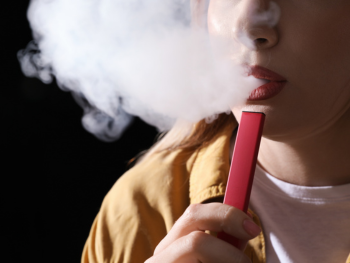Expert comment Last updated 14 April 2023

Using vapes is the “lesser of two evils”, vaping's long-term health impacts are still unknown, and the Government needs a whole raft of measures if it is to meet its target of being smoke-free by 2030, according to a leading academic.
One million smokers will be encouraged to swap cigarettes for vapes under a new ‘swap to stop’ scheme designed to improve the health of the nation and cut smoking rates.
Almost one in five smokers in England will be provided with a vape starter kit to help them quit the habit as the Government seeks to meet its ambition of being smoke-free by 2030 – which means reducing smoking rates to 5% or less.
But Dr Salim Khan, Head of Department: Public Health at Birmingham City University, says such an initiative carries risks.
“If we're swapping the evil for a lesser of two evils, what are we going to do about the lesser of two evils? What's the strategy for that?” he asks. “Is vaping better than smoking? The answer is ‘yes’. Tobacco smoke contains many chemicals that are harmful to both smokers and non-smokers. Breathing even a little tobacco smoke can be harmful.
“Of the more than 7,000 chemicals in tobacco smoke, at least 250 are known to be harmful, including hydrogen cyanide, carbon monoxide, and ammonia. Among the 250 known harmful chemicals in tobacco smoke, at least 69 can cause cancer. Burning tobacco also contains heavy metals which can affect the brain and cause long-term damage.
“Vapes also contain nicotine, a highly addictive drug, and nicotine inhalation has been shown to have an impact on the lungs. We know that and that's been proven by research.
"The intention of this vaping initiative is to wean people off cigarette smoking and then stop them from using vapes. Well, where is the guarantee that they are weaned off the vapes? What support is going to be put in place to wean people off nicotine after they've effectively switched to vaping. You've got to have those support mechanisms in place.
“A lot of young adults assume vaping is risk-free and it's not. There needs to be a holistic approach to tackle this. Otherwise, reducing the number of smokers to five per cent of the population in seven years is highly improbable. Without a considered approach implementing a number of interventions, I think it's more realistic to look at 2035 or 2040.”
Dr Khan adds: “What we tend to see with people using a vape is, because it's accessible and can be easily put in a pocket, they tend to constantly puff on it.
"A vape can have up to 3,500, even 4,000, puffs depending on its size. The problem then is you're inhaling quite a large amount of nicotine directly into the lungs, and then into the bloodstream. This is a big issue. There is no data on the long-term impacts of that inhalation. Because we don't have evidence-based answers, we've got to err on the side of caution.
“We also know that there are a lot of people manufacturing vapes and vaping liquids which aren't regulated in any way. If it’s not regulated, you've got no idea what chemicals are going into these. So you've potentially got a lot of harmful toxins that are being inhaled which, fundamentally, can cause a lot more harm than good.”